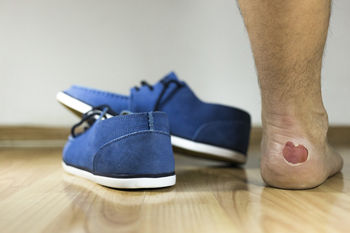



Blisters can be an unsightly and potentially uncomfortable affliction on the foot. Essentially, blisters are areas on the feet that have excess liquid in between layers of skin. There are many different causes of blisters that you might notice on your feet. Commonly, blisters can form on areas of the feet, particularly the toes, when an individual wears a new, ill-fitting pair of shoes. The friction produced by a tight pair of shoes can consequently create a blister. Another common cause of blisters on the feet is overexposure to the sun. When an individual gets a sunburn on their feet and lower legs, blisters that are small and white can appear causing pain and an itching sensation. Blisters may also be the result of excessive moisture around the feet. Specifically, when the feet sweat too much, the excessive sweat can ultimately clog the pores of the feet creating blisters. Knowing the specific cause of the blisters on your feet can help determine the correct treatment. If you have blisters on your feet, contact a podiatrist who can help you address the problem.
Blisters are prone to making everyday activities extremely uncomfortable. If your feet are hurting, contact our podiatrist of Dr. Powers Foot and Ankle. Our doctor can provide the care you need to keep you pain-free and on your feet.
Foot Blisters
Foot blisters develop as a result of constantly wearing tight or ill-fitting footwear. This happens due to the constant rubbing from the shoe, which can often lead to pain.
What Are Foot Blisters?
A foot blister is a small fluid-filled pocket that forms on the upper-most layer of the skin. Blisters are filled with clear fluid and can lead to blood drainage or pus if the area becomes infected.
How Do Blisters Form?
Blisters on the feet are often the result of constant friction of skin and material, usually by shoe rubbing. Walking in sandals, boots, or shoes that don’t fit properly for long periods of time can result in a blister. Having consistent foot moisture and humidity can easily lead to blister formation.
Prevention & Treatment
It is important to properly care for the affected area in order to prevent infection and ease the pain. Do not lance the blister and use a Band-Aid to provide pain relief. Also, be sure to keep your feet dry and wear proper fitting shoes. If you see blood or pus in a blister, seek assistance from a podiatrist.
If you have any questions, please feel free to contact one of our offices located in Bloomington, Bedford, and Washington, IN . We offer the newest diagnostic and treatment technologies for all your foot care needs.